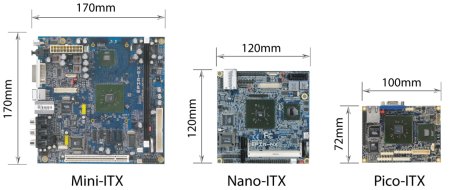Kontron spins pico-ITX SBC
Mar 10, 2009 — by LinuxDevices Staff — from the LinuxDevices Archive — 21 views Kontron has announced its first pico-ITX SBC (single board computer), packing Intel's Atom processor. Targeting small, multimedia-oriented devices, the “pITX-SP” offers 1.1GHz or 1.6GHz Intel Z5xx CPUs, gigabit Ethernet, two SATA II ports, a microSD slot, and a DVI port, the company says.
Kontron has announced its first pico-ITX SBC (single board computer), packing Intel's Atom processor. Targeting small, multimedia-oriented devices, the “pITX-SP” offers 1.1GHz or 1.6GHz Intel Z5xx CPUs, gigabit Ethernet, two SATA II ports, a microSD slot, and a DVI port, the company says.
(Click here for a larger view of Kontron's pITX-SP)
Kontron's new pITX-SP uses the little 3.9 x 2.8 inch (10 x 7.2cm) pico-ITX format introduced by Via at the beginning of January 2007. The form factor has approximately half the surface area of Via's already small 4.7 x 4.7-inch (12 x 12cm) Nano-ITX standard, and is considerably smaller than the original 6.7-inch square (17 x 17cm) mini-ITX standard.

Via's incredible shrinking motherboard
(Click for details)
Most pico-ITX boards seen to date have come from Via itself and, not surprisingly, sported Via processors and chipsets. Examples include the Epia PX10000G, with a 1GHz C7 CPU, the Epia PX5000G, with a 500MHz Eden ULV, and the Epia P700, offering a 1GHz C7 or 500MHz Eden ULV and optional “wings” offering an expanded array of “real world” connectors.
 Axiomtek's PICO820 (Click image for further information) |
Last year, however, Via transferred ownership of Pico-ITX to the SFF-SIG (small form factor special interest group), which is now maintaining it as an open, vendor-neutral standard. And in September, Axiomtek introduced its PICO820, claimed to be the first pico-ITX board using Intel's Atom Z5xx processors.
Kontron's new pITX-SP uses the same Intel chips as the PICO820, namely Intel's 1.1GHz Z510 or 1.6Ghz Z530. Both CPUs measure just 14 x 13mm, have two-Watt TDPs, and are paired with the comparatively huge SCH US15W companion chip.
Like Axiomtek's board, the pITX-SP hasn't yet sprouted SUMIT (stackable unified module interconnect technology) connectors, being proposed as part of the SFF-SIG's Pico-ITXe specification (for further details, see our earlier coverage, here). Hence, it lacks PCI Express expansion. But, with a combination of real-world connectors on one “coastline” and pin headers, the pITX-SP is able to offer a variety of interfaces.
The real-world connectors at the board's edge include a DVI port, said to support displays up to 1920 x 1080, a gigabit Ethernet port, two USB 2.0 ports, and a power input designed to accept 5VDC. The board also includes two SATA II ports, plus pin headers for both analog and S/PDIF (Sony/Philips digital interconnect format) digital audio, LVDS video, GPIO, SDIO, and two additional USB ports, says Kontron.
Not visible in our photo, and presumably located on the back of the pITX-SP, is a microSD slot for memory expansion. The back of the SBC also apparently holds an SODIMM slot, cited by Kontron as accepting up to 1GB of DDR2 memory.
Features and specifications listed by Kontron for the pITX-SP include:
- Processor — Intel Atom Z510 (1.1GHz) or Z530 (1.6GHz)
- Memory — Up to 1GB of DDR2 RAM, via single SODIMM slot
- Storage — SATA ports, plus microSD slot
- Display — Supports DVI-interfaced displays with resolutions of up to 1920 x 1080, and LVDS-interfaced displays at up to 1280 x 1024
- Networking — 1 x gigabit Ethernet
- Other I/O:
- 1 x DVI
- 1 x LVDS (pin header)
- 4 x USB (2 via real-world ports, 2 via pin headers)
- 1 x SDIO (pin header)
- 2 x SATA II
- 1 x PATA
- GPIO
- HD audio
- S/PDIF
- 1 x DVI
- Expansion — microSD slot
- Operating temperature — 0 to 60 deg. C
- Dimensions — 3.9 x 2.8 inches (100mm x 72mm)
Availability
According to Kontron, the pITX-SP supports Linux, Windows XP Embedded, Windows XP, and Windows Vista. While pricing was not released, the company said the board will be sampling this month.
More information on the pITX-SP may be found on the Kontron website, here.
This article was originally published on LinuxDevices.com and has been donated to the open source community by QuinStreet Inc. Please visit LinuxToday.com for up-to-date news and articles about Linux and open source.